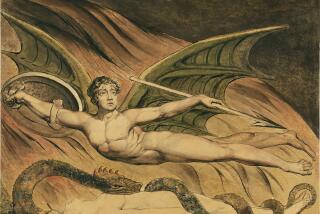ART REVIEW : A STROLL AMONG BRITISH LANDSCAPES
- Share via
The British are born to travel. Historically, just about any sort of trip seemed to suit them. Sir Francis Drake loved bounding the main. Eighteenth-Century gentlefolk with pretensions to culture had to make the European Grand Tour by coach, post chaise, hook or crook.
Before the invention of the voracious camera, the colloquial language of visual memory was the watercolor. The traveler to Venice or Bath either puddled one up himself, purchased from a local hack or, if he was lucky and rich, had a view executed by one of those leading artists who loved to travel even more than most people.
Given such circumstances, it is no surprise that there is a huge body of British watercolor landscapes of every stamp. What is a surprise is that San Marino’s Huntington Gallery with its own copious and distinguished collection is still able to find, in private hands, works it deems worthy of a turn in its public galleries.
“British Landscape Watercolors,” on view through February, consists of 41 sheets on loan from four local private collectors who wish to remain anonymous. In an era when collectors hire public relations firms to hype their aesthetic sagacity, this is a big relief. So is the show.
It is a browser. Humpf, that Gainsborough pastoral tells something about why his work always has such sparkle. Everything is executed with an airy circularity like dandelion puffs. Makes the whole picture seem to float.
Wuzzat? They wouldn’t show a set drawing for a Steven Spielberg science-fiction film at the Huntington. But that vast electric panorama looks like the world is about to explode just as fleets of Klingon star ships descend. Of course. It’s John Martin, granddaddy of the horrific-apocalypse branch of the Sublime.
What a bunch. There’s a snippet of pictorial brilliance by J. M. W. Turner, a visual genius, and not far away a sensitive view of Venice by Edward Lear, whom we think of as a nonsense poet. These guys were amateur professionals or professional amateurs, which only means they let all their sides show.
That picture of a chestnut tree struck by lightning is probably an accurate report of something John Sell Cotman saw, but it also has a special spiritual stillness.
Thomas Shotter Boys has a common sympathetic touch that makes his French views look like illustrations for “A Tale of Two Cities,” and Francis Towne’s stuff is so streamlined he was completely forgotten until the Art Deco crowd rediscovered him in the 1930s.
This show is as relaxing as a stroll on an empty beach. Probably because it isn’t about anything. No, it is about being bright and civilized in a relaxed way.
More to Read
The biggest entertainment stories
Get our big stories about Hollywood, film, television, music, arts, culture and more right in your inbox as soon as they publish.
You may occasionally receive promotional content from the Los Angeles Times.










